
Sandpipers are a large family, Scolopacidae, of waders. They include many species called sandpipers, as well as those called by names such as curlew and snipe. The majority of these species eat small invertebrates picked out of the mud or soil. Different lengths of bills enable different species to feed in the same habitat, particularly on the coast, without direct competition for food.

The common redshank or simply redshank is a Eurasian wader in the large family Scolopacidae.
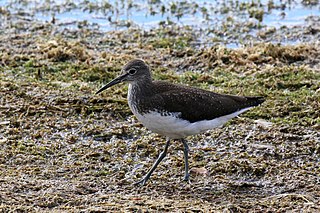
The green sandpiper is a small wader (shorebird) of the Old World.

Tringa is a genus of waders, containing the shanks and tattlers. The genus name Tringa is the New Latin name given to the green sandpiper by the Italian naturalist Ulisse Aldrovandi in 1599. They are mainly freshwater birds, often with brightly coloured legs as reflected in the English names of six species, as well as the specific names of two of these and the green sandpiper. They are typically associated with northern hemisphere temperate regions for breeding. Some of this group—notably the green sandpiper—nest in trees, using the old nests of other birds, usually thrushes.

The solitary sandpiper is a small shorebird. The genus name Tringa is the New Latin name given to the green sandpiper by Aldrovandus in 1599 based on Ancient Greek trungas, a thrush-sized, white-rumped, tail-bobbing wading bird mentioned by Aristotle. The specific solitaria is Latin for "solitary" from solus, "alone".

The spotted redshank is a wader (shorebird) in the large bird family Scolopacidae. The genus name Tringa is the New Latin name given to the green sandpiper by Aldrovandus in 1599 based on Ancient Greek trungas, a thrush-sized, white-rumped, tail-bobbing wading bird mentioned by Aristotle. The specific erythropus is from Ancient Greek eruthros, "red", and pous, "foot".
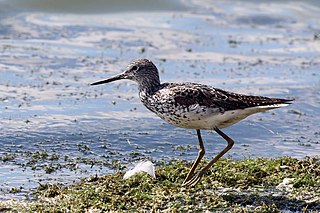
The common greenshank is a wader in the large family Scolopacidae, the typical waders. The genus name Tringa is the New Latin name given to the green sandpiper by Aldrovandus in 1599 based on Ancient Greek trungas, a thrush-sized, white-rumped, tail-bobbing wading bird mentioned by Aristotle. The specific nebularia is from Latin nebula "mist". Like the Norwegian Skoddefoll, this refers to the greenshank's damp marshy habitat.

The willet, formerly in the monotypic genus Catoptrophorus as Catoptrophorus semipalmatus, is a large shorebird in the family Scolopacidae. It is a relatively large and robust sandpiper, and is the largest of the species called "shanks" in the genus Tringa. Its closest relative is the lesser yellowlegs, a much smaller bird with a very different appearance apart from the fine, clear, and dense pattern of the neck, which both species show in breeding plumage. It breeds in North America and the West Indies and winters in southern North America, Central America, the West Indies and South America.

The greater yellowlegs is a large North American shorebird. The genus name Tringa is the New Latin name given to the green sandpiper by Aldrovandus in 1599 based on Ancient Greek trungas, a thrush-sized, white-rumped, tail-bobbing wading bird mentioned by Aristotle. The specific melanoleuca is from Ancient Greek melas, "black", and leukos, "white".

The lesser yellowlegs is a medium-sized shorebird. The genus name Tringa is the New Latin name given to the green sandpiper by Aldrovandus in 1599 based on Ancient Greek trungas, a thrush-sized, white-rumped, tail-bobbing wading bird mentioned by Aristotle. The specific flavipes is from Latin flavus, "yellow", and pes, "foot".

The common sandpiper is a small Palearctic wader. This bird and its American sister species, the spotted sandpiper, make up the genus Actitis. They are parapatric and replace each other geographically; stray birds of either species may settle down with breeders of the other and hybridize. Hybridization has also been reported between the common sandpiper and the green sandpiper, a basal species of the closely related shank genus Tringa.

The marsh sandpiper is a small wader. It is a rather small shank, and breeds in open grassy steppe and taiga wetlands from easternmost Europe to the Russian Far East. The genus name Tringa is the New Latin name given to the green sandpiper by Aldrovandus in 1599 based on Ancient Greek trungas, a thrush-sized, white-rumped, tail-bobbing wading bird mentioned by Aristotle. The specific stagnatilis is from Latin stagnum, "swamp".
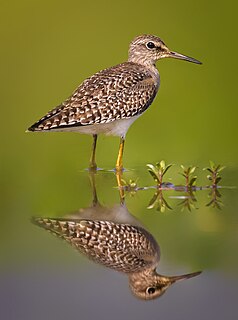
The wood sandpiper is a small wader. This Eurasian species is the smallest of the shanks, which are mid-sized long-legged waders of the family Scolopacidae. The genus name Tringa is the New Latin name given to the green sandpiper by Aldrovandus in 1599 based on Ancient Greek trungas, a thrush-sized, white-rumped, tail-bobbing wading bird mentioned by Aristotle. The specific glareola is from Latin glarea, " gravel".

The curlew sandpiper is a small wader that breeds on the tundra of Arctic Siberia.

The Terek sandpiper is a small migratory Palearctic wader species and is the only member of the genus Xenus. It is named after the Terek River which flows into the west of the Caspian Sea, as it was first observed around this area.
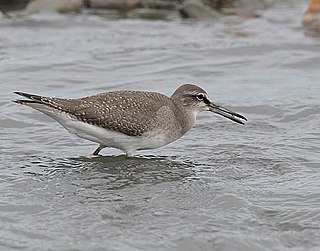
The grey-tailed tattler or Polynesian tattler, Tringa brevipes is a small, foraging shorebird in the genus Tringa. The English name for the tattlers refers to their noisy call. The genus name Tringa is the New Latin name given to the green sandpiper by Aldrovandus in 1599 based on Ancient Greek trungas, a thrush-sized, white-rumped, tail-bobbing wading bird mentioned by Aristotle. The specific brevipes is from Latin brevis, "short", and pes, "foot".

The surfbird is a small stocky wader in the family Scolopacidae. It was once considered to be allied to the turnstones, and placed in the monotypic genus Aphriza, but is now placed in the genus Calidris.
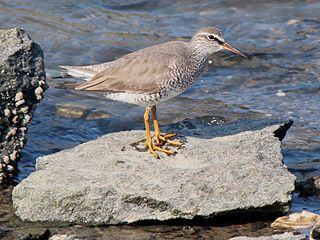
The tattlers are the two very similar bird species in the shorebird genus Tringa. They formerly had their own genus, Heteroscelus. The old genus name means "different leg" in Greek, referring to the leg scales that differentiate the tattlers from their close relatives, the shanks.

The wandering tattler, is a medium-sized wading bird. It is similar in appearance to the closely related gray-tailed tattler, T. brevipes. The tattlers are unique among the species of Tringa for having unpatterned, greyish wings and backs, and a scaly breast pattern extending more or less onto the belly in breeding plumage, in which both also have a rather prominent supercilium.

Laem Phak Bia is a coastal area in Ban Laem District, Phetchaburi Province, Thailand. The shore is a large, open area of mudflats and salt pans, with some mangrove areas and scrub, tipped by a sand spit. The area is not a national park, the land being privately owned, but it is a favoured location for bird-watchers where they can see a wide variety of shorebirds. The area is administered as Laem Phak Bia Subdistrict, and is home to a village of the same name.
























